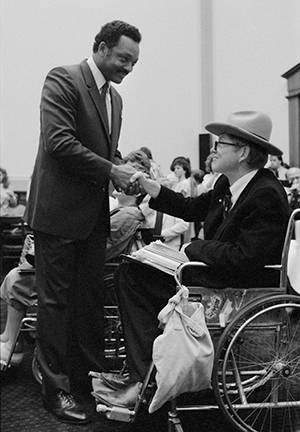The Disability Rights Movement in America
by Jaipreet Virdi
 Disabled people have always fought for their rights.
Disabled people have always fought for their rights.
This is because they know that every policy issue, health crisis, inaccessible space, and fight for justice is a disability issue. Demanding access and advocacy for all people, disabled protesters have rallied against social barriers, created equitable opportunities, fought to secure social services, and achieved milestones in legislation. Achieving remarkable success, they’ve proved to the world that disability does not mean that someone is incapable.
Yet so many disabled people’s lives and achievements are left out of history lessons. Learning disability history brings this ancestral past to light. It begins with the recognition that disabled people have always been a part of society, but it was not until the late nineteenth century that they were increasingly segregated, institutionalized, and sterilized under the new science of eugenics that declared their lives worthless. Deaf people had their language stripped from them. Mentally and physically disabled people were kept in underfunded and understaffed institutions for years. Some never reunited with their families. Hundreds were forgotten.
Disabled people pushed back against discrimination. Their fights were for dignity and freedom: to make their own decisions about their bodies, to live independently, and to get access to essential healthcare and assistive technologies that they needed to be self-sufficient. They fought not just for themselves, but for future generations. Activist Judith Heumann writes of this: “You drop a petal in the water, and it has a ripple effect.”
As the Civil Rights Movement ignited waves of protests for rights across the country, disabled people created direct-action groups to seek out full inclusion in society. The Disabled in Action group led sit-in protests across the country to demand the passage of Section 504 of the 1973 Rehabilitation Act, which prohibited discrimination on the basis of disability. For four weeks in 1977, protesters occupied the Department of Health, Education and Welfare office in San Francisco, joining coalitions such as the Black Panther Party to hold the longest non-violent occupation of an American federal building. It was a historic milestone that provided disabled people federal civil rights protection for the first time and sparked similar transformations, including the Education of Handicapped Children Act in 1975 (later IDEA), which provided equal access to education; the American Disabled for Accessible Public Transit, which fought against wheelchair inaccessibility of public buses in 1977; and the 1988 Deaf President Now! campaign, which aimed to empower deaf people.
The results of all these protests culminated in March 1990 when thousands of activists from thirty states headed to Capitol Hill in Washington, DC, to demand the passage of the most significant legislation for disability rights—the Americans with Disabilities Act (ADA). After a series of rallies and speeches, sixty activists abandoned their crutches, wheelchairs, and walkers and climbed the eighty-three stone steps that led up to the Capitol to symbolize the barriers that disabled people experience daily. Four months later, President George H. W. Bush signed the ADA into law, saying, “Let the shameful wall of exclusion finally come tumbling down.”
But the fight is far from over. Disabled people still experience discrimination and are disproportionally impacted by systemic medical bias, racism, and ableism. They are always the first to place their bodies on the line in the fight for equality, and this is why we need to remember the work they’ve done and embrace our collective history so we can join their battles and continue fighting for equality and equity.
Jaipreet Virdi is an associate professor of history at the University of Delaware specializing in the history of medicine, technology, and disability. She is the author of Hearing Happiness: Deafness Cures in History (University of Chicago Press, 2020). She is pursuing questions about how disabled people tinkered with their prostheses and perceived them as extensions of themselves, and how we think of deafness and deaf/tech collaborations. This essay was orginally written in 2023 for the TLTH lesson unit “The Disability Rights Movement, 1950–1990” by Kory Loyola.